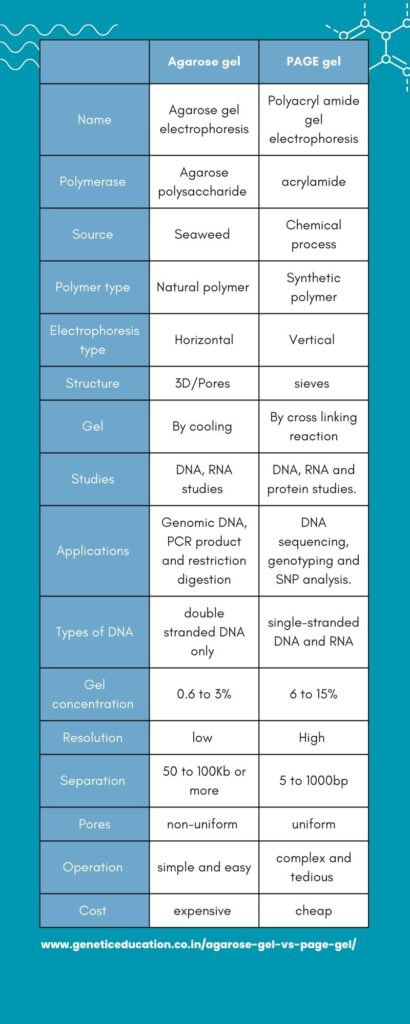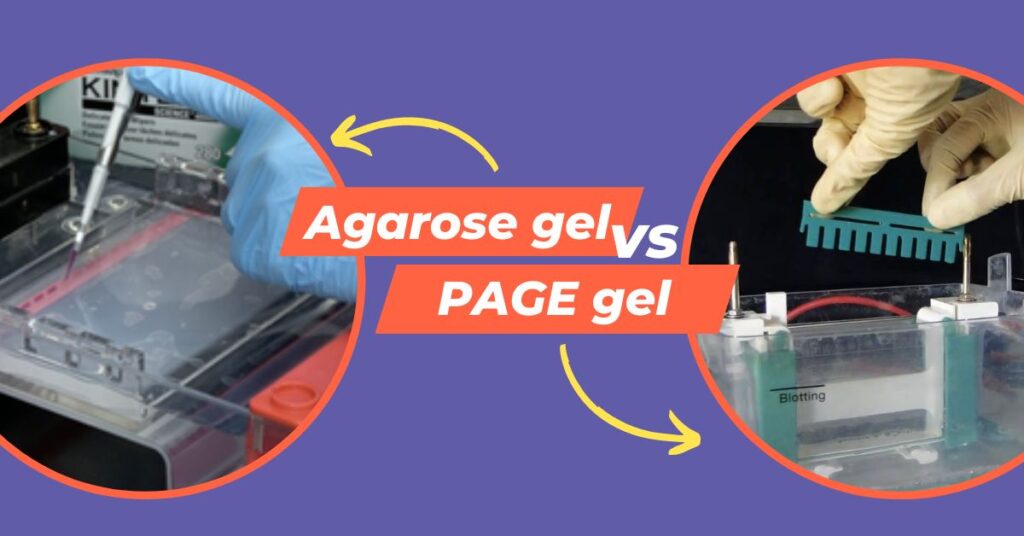“Explore the comparison between Agarose and PAGE gel and find out which is for which. Understand the differences in their composition, working, applications and more in the present article.”
DNA analysis highly relies on gel electrophoresis which is a technique to separate and analyze DNA or RNA. The separation is based on two properties– the charge and mass of the molecule.
Thus, negatively charged molecules (like DNA) migrate toward the positive charge and vice versa. In addition, larger molecules migrate slower in the gel. These two properties help produce differential banding patterns and help in nucleic acid analysis depending on their size difference. The two most common electrophoresis techniques are agarose gel and PAGE.
Agarose gel electrophoresis is commonly used in molecular genetics but it is important to note that agarose gel and PAGE gel have differences in their composition and applications. These distinct properties make them unique and thus utilized for different purposes.
In this article, we will understand what agarose gel and PAGE gel is and what are some of the differences between them. We will majorly focus on the technical and practical differences.
Stay tuned.

Key Topics:
What is agarose gel?
Agarose gel is composed of agarose (polysaccharide) extracted from seaweed. It is used in horizontal gel electrophoresis and can separate DNA and RNA effectively. It is used to isolate larger DNA fragments. The typical separation range is ~50 bp to 10 to 100 Kb.
It has applications in genomic DNA, PCR, library DNA and restriction digestion studies. It is a low-resolution gel.
What is PAGE?
PAGE is Polyacrylamide gel electrophoresis. The PAGE gel is made up of a synthetic acrylamide substance. It can separate a few base pairs to a few hundred base pair DNA fragments and thus has higher resolution.
It is used particularly in the study of DNA sequencing analysis. For example, the conventional Sanger sequencing technique highly relies on the PAGE gel analysis having the power to separate a single base difference.
Similarities between Agarose gel and PAGE:
- Agarose and PAGE gel are used in the technique known as electrophoresis. It can separate any biomolecule based on its size and charge.
- Agarose and PAGE gel is commonly used in the separation of nucleic acid- DNA and RNA.
- Both techniques are significantly important in molecular genetic studies like PCR analysis, restriction digestion, DNA sequencing studies, etc.
- Both create porous matrix structures to migrate DNA.
Differences between Agarose gel vs PAGE:
Agarose gel electrophoresis requires agarose gel. It is made up of agarose polysaccharides derived from the seaweeds. Contrary, the Polyacrylamide gel electrophoresis requires PAGE gel. It is made up of synthetic polyacrylamide polymers.
Thus agarose gel is composed of natural polymers while PAGE gel is composed of synthetic or artificial polymers.
AGE is also known as horizontal gel electrophoresis as it runs DNA in a horizontal setup while PAGE is known as vertical gel electrophoresis as it runs DNA vertically.
The agarose gel prepares a 3D porous structure by bonding the long chain of polysaccharide sugar molecules, however, PAGE prepares a sieve structure by interlinking between acrylamide and bis-acrylamide.
At a chemical level, the hydrogen bonds between sugar molecules create a porous agarose gel structure, while covalent cross-linking between acrylamide and bis-acrylamide creates a porous PAGE gel structure.
Thus, the pore size in agarose gel is less uniform while the pore size in PAGE is comparatively more uniform.
Moreover, weak hydrogen bonds make the agarose gel less stable while the covalent cross-linking makes the PAGE gel more stable.
Agarose gel is chemically more complex and creates a 3D porous structure while the PAGE gel is chemically less complex and prepares molecular sieves.
It is important to note that the agarose gel sets after cooling while the PAGE gel sets by the chemical reaction between acrylamide and bis-acrylamide.
So, agarose gel settles in less time while PAGE gel takes more time to settle and prepare a gel structure.
The concentration of agarose gel is an important factor in deciding the pore size of a gel while the ratio of acrylamide to bis-acrylamide is a factor that helps decide the pore size in PAGE. At increasing agarose gel concentration, the pore size decreases and vice versa.
Usually, the concentration of agarose gel is ranging between 0.7 to 3% (0.8%, 2% and 3% for genomic DNA, PCR products and restriction digestion, respectively) while the concentration of PAGE is ranging from 6 to 15%.

Agarose gel is only used in the study of nucleic acids (DNA or RNA) while PAGE can be used for DNA, RNA and protein studies as well.
Agarose gel has lower resolution while PAGE has higher resolution power.
Agarose gel can effectively separate larger DNA fragments from ~100bp to 100Kb or more while PAGE gel can effectively separate smaller DNA fragments from a few base pairs to a few hundred or thousand base pairs.
Hence, agarose gel electrophoresis is popularly used in the separation of genomic DNA, PCR products and restriction digestion analysis whereas PAGE is popularly used in DNA sequencing analysis which requires higher resolution.
Furthermore, agarose gel can separate double-stranded DNA only while the PAGE gel can separate single-stranded DNA and RNA.
Agarose is commonly used for genomic DNA runs, DNA fragment analysis, PCR, restriction digestion, plasmid preparation and library validation while PAGE gel is used for precise DNA fragment analysis including DNA sequencing, genotyping, SNP analysis, protein-DNA interaction studies and mutation analysis.
Technically, the agarose gel setup is simple and easy to operate while the PAGE is a complex and tedious process and hence requires experience to perform the operation. This is the major reason why agarose gel is commonly used in molecular labs.
However, agarose gel electrophoresis is more expensive compared to PAGE setup.
Agarose gel is non-toxic but contains potent carcinogen EtBr while the PAGE is highly neurotoxin. Care must be taken during preparation and operation.
Read more:
- Factor Affecting DNA Agarose Gel Electrophoresis Results.
- How to Extract DNA From a Gel?- A Step-By-Step Guide
- Different Types of DNA/RNA Gel Electrophoresis and Their Applications
- Common Issues in DNA/RNA Gel Electrophoresis and Troubleshooting
Wrapping up:
In summary, both agarose gel and PAGE techniques have played crucial roles in genetic and genomic studies. However, agarose gel is more popular due to its simple setup and easy handling. The emergence of capillary electrophoresis, a newer and more advanced form of gel electrophoresis, offers faster, more accurate, and safer analysis compared to traditional PAGE gel.
By the way, I’ve also written an article on capillary gel electrophoresis. Feel free to check it out! Additionally, our blog features more articles on agarose gel electrophoresis that you might find interesting.
Happy reading and exploring the fascinating world of gel electrophoresis!


